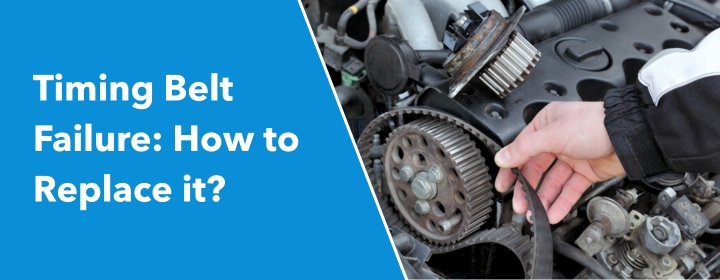
Timing Belt Failure: How to Replace it?
Timing belts are that one thing in your car you don’t really think about… until it snaps. And when it does? Your engine’s basically screaming “why didn’t you replace me?” Replacing a timing belt isn’t glamorous. In this guide, we’ll walk you through what actually happens when a timing belt failure occurs, and how to swap it.
Timing Belt Failure
Think of the timing belt as the silent conductor of your engine. It keeps the crankshaft and camshaft in perfect sync so your valves open and close exactly when they should. Miss a beat, and valves and pistons can collide. Massive engine damage.
Most people ignore timing belts until it’s too late. They’re made of rubber, sometimes with some reinforcing fibers. Over time, heat, oil leaks, and just plain wear eat it away. Cracks, frays, glazing, chunks missing – that’s the death march warning.
When a timing belt fails? You might hear a pop, or your car just dies. No rev, no restart. In some engines (interference engines), failure means bent valves, ruined pistons, maybe a whole head rebuild. In non-interference engines, lucky you – the engine just stops, no internal carnage.
Why it Happens?
- Age kills: Timing belts aren’t forever. They dry out, crack, stretch. Rubber doesn’t last forever, and heat is its mortal enemy. So even if your car barely moves, that belt is aging like a loaf of bread left in the sun.
- Mileage: Manufacturers give you a number, 60k, 90k, 100k miles. Hit that mark and you’re gambling if you skip it. Some belts snap right on schedule. Others limp along, but any second you push it past that window, you’re flirting with disaster.
- Oil leaks are sneaky killers: A little drip here or there onto the belt? Doesn’t look like much, but rubber plus oil is basically a death sentence. It weakens the belt fibers, and then snap – boom.
- Tension issues: Too tight or too loose, either one will ruin a belt faster than you think. It’ll either fray or slip. And the worst part? You won’t feel it until it’s gone. Some cars have tensioners that fail quietly, and no, checking them isn’t fun.
- Debris: Little stones, dust, grime getting in there. It’s not the main killer, but it’s the icing on the cake. One weird chunk of metal or hardened grime, and the belt can start eating itself.
How to Replace?
Get your stuff ready
Don’t even think about starting. You need:
- A new timing belt (duh)
- Tensioner and idler pulleys (replace them while you’re at it – trust me)
- Socket set, wrenches, screwdrivers
- Jack and stands, or a lift if you’re fancy
- Some kind of marker or chalk
- Patience
Turn off the engine and clear space
Disconnect the battery. Move anything out of the way: engine covers, belts, maybe even the wheel if your car’s cramped. Take pics. Seriously, take pics of everything. It will save you hours when you’re reassembling.
Align the engine timing
This is the golden rule: line up your timing marks on the crankshaft and camshaft. If your car has a TDC (top dead center) mark, use it. Don’t skip this – if your timing is off, valves meet pistons and… bad things.
Remove the old belt
Loosen the tensioner, slide the belt off. Note the belt’s routing. Again, take a pic or two. Check pulleys and tensioner. If they’re worn, replace now.
Put on the new belt
Start at the crank, follow the path exactly. Keep tension on the non-tensioner side — slack will bite you later. Once the belt is on, rotate the tensioner to set it tight. Don’t overdo it.
Double-check timing
Manually rotate the crank 2 full turns, back to TDC, check marks again. If they don’t line up, stop. Fix it. If you miss this, you’re looking at a $1,000+ repair.
Reassemble and test
Put everything back. Belts, covers, battery. Start the engine. Listen for weird noises. If it’s smooth, you’re golden.
Purchase the Timing belt with Car Engine Guru
- Hit the website: Opened CarEngineGuru.com. First thing I noticed – it’s not one of those fancy, over-designed sites. Simple, straight to the point. I typed in my car make and model. Boom, it gave me options. No guessing.
- Pick the timing belt: Scrolled through, found the timing belt that matches my engine. There were specs listed – nothing too scary, just the basics: part number, compatibility, price. Clicked “Add to Cart.” Easy.
- Check out: Here’s the fun part – the checkout wasn’t one of those annoying, multi-page deals. Enter card info, shipping address, promo codes if you got any. Done. Hit submit. Instant confirmation email.
- Wait for it: Shipping was faster than I expected. Not overnight, but I got tracking info, and they updated me at every step. No guessing if my belt was lost somewhere in the void.
- Unbox & inspect: Belt arrives. Open the box – smells like… new rubber, nothing else. Looked exactly like the pic on the site. No weird defects, no “oh crap” moments. Checked part number, fits my car perfectly.
- Install or stash for later: Either put it on your engine yourself (if you’re brave) or hand it off to your mechanic. Either way, you know the part is legit. No sketchy knockoffs here.
